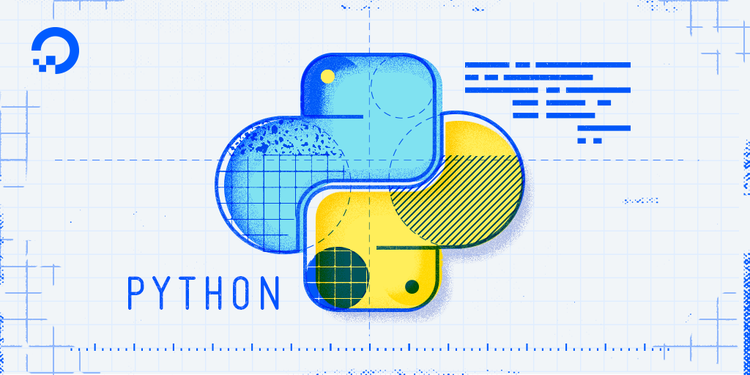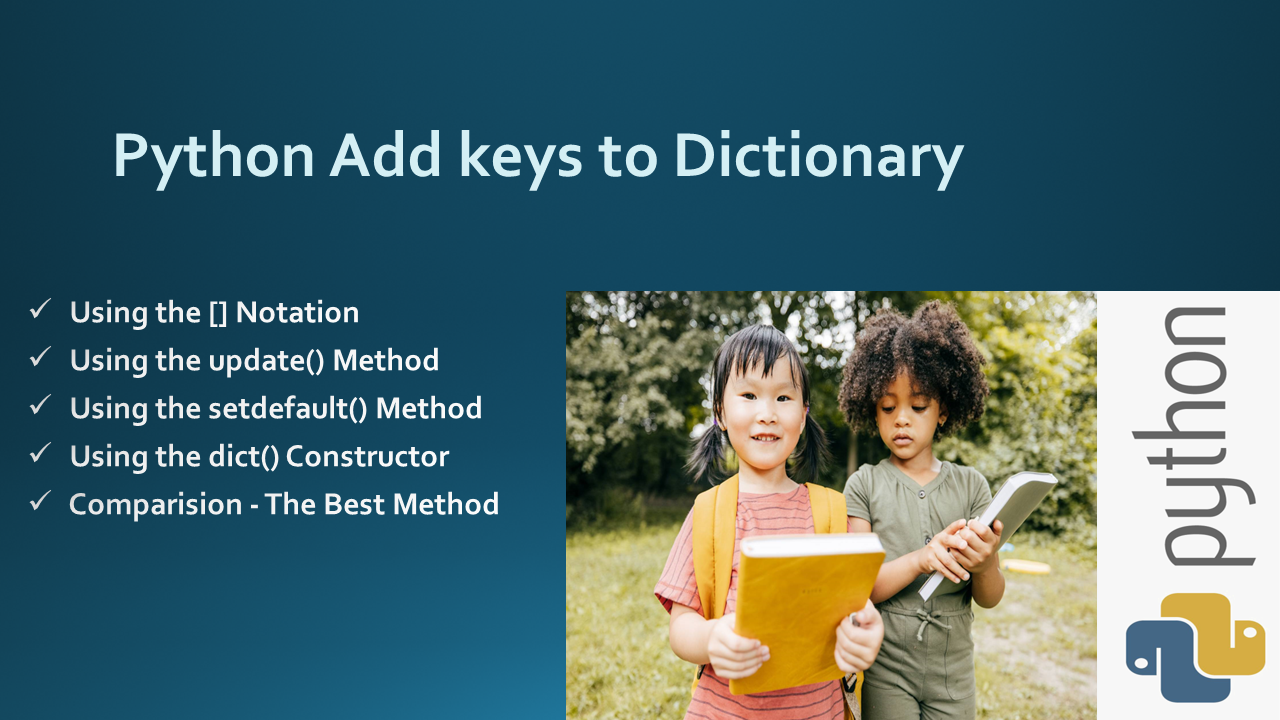Python Add Keys to Dictionary: Easy Guide
Learn different ways to effortlessly add new keys and values to dictionaries in Python, enhancing your data manipulation skills.
Learn different ways to effortlessly add new keys and values to dictionaries in Python, enhancing your data manipulation skills.
In Python, dictionaries are mutable data structures that store data in key-value pairs. Adding new keys to a dictionary is a common operation. Let's explore different methods to accomplish this:
To add new keys to a dictionary in Python, you can use the following methods:
Direct assignment:
[].d = {'key': 'value'}
print(d) # Output: {'key': 'value'}
d['mynewkey'] = 'mynewvalue'
print(d) # Output: {'key': 'value', 'mynewkey': 'mynewvalue'}The update() method:
update() method can be used to add multiple key-value pairs from another dictionary or an iterable of key-value pairs.d = {'key1': 'value1'}
d.update({'key2': 'value2', 'key3': 'value3'})
print(d) # Output: {'key1': 'value1', 'key2': 'value2', 'key3': 'value3'}Merging dictionaries (Python 3.5+):
** operator to merge two dictionaries.d1 = {'a': 1, 'b': 2}
d2 = {'b': 3, 'c': 4}
d3 = {**d1, **d2}
print(d3) # Output: {'a': 1, 'b': 3, 'c': 4}The update operator |= (Python 3.9+):
update() method, the |= operator updates a dictionary with key-value pairs from another dictionary or an iterable.d1 = {'a': 1, 'b': 2}
d2 = {'b': 3, 'c': 4}
d1 |= d2
print(d1) # Output: {'a': 1, 'b': 3, 'c': 4}These are some of the common ways to add new keys to a dictionary in Python. Choose the method that best suits your needs and coding style.
This Python code demonstrates four methods to add new key-value pairs to dictionaries: direct assignment, using the update() method, merging dictionaries using the unpacking operator (**), and using the update operator (|=). Each method is illustrated with an example and its output.
# Method 1: Direct assignment
d = {'key': 'value'}
print("Original dictionary:", d)
d['mynewkey'] = 'mynewvalue'
print("Dictionary after adding a new key:", d)
# Method 2: The update() method
d = {'key1': 'value1'}
d.update({'key2': 'value2', 'key3': 'value3'})
print("Dictionary after updating with multiple keys:", d)
# Method 3: Merging dictionaries (Python 3.5+)
d1 = {'a': 1, 'b': 2}
d2 = {'b': 3, 'c': 4}
d3 = {**d1, **d2}
print("Merged dictionary:", d3)
# Method 4: The update operator |= (Python 3.9+)
d1 = {'a': 1, 'b': 2}
d2 = {'b': 3, 'c': 4}
d1 |= d2
print("Dictionary updated using |= operator:", d1)This code demonstrates all four methods of adding new keys to a dictionary in Python with clear explanations and output for each method.
Importance of Mutability: Dictionaries are mutable, meaning you can change their contents (add, update, or delete key-value pairs) after creation. This flexibility makes them powerful for dynamic data manipulation.
Key Uniqueness: Dictionary keys must be unique. If you try to add a key that already exists, you'll overwrite its associated value.
Key Data Types: Keys must be immutable data types like strings, numbers, or tuples. You'll get an error if you try to use a mutable type like a list as a key.
Efficiency: Direct assignment (d['new_key'] = 'new_value') is generally the fastest way to add a single key-value pair.
Bulk Updates: The update() method and the |= operator are more efficient for adding multiple key-value pairs at once.
Merging Considerations: When merging dictionaries, be mindful of duplicate keys. The values from the later dictionaries will take precedence.
Python Version Awareness: The merging operator (**) and the update operator (|=) are available in Python 3.5+ and 3.9+ respectively. Be aware of these version requirements in your code.
Alternatives to Dictionaries: While dictionaries are versatile, consider other data structures like lists of tuples or custom classes if you need specific ordering or more complex data relationships.
This article outlines four methods for adding new keys to dictionaries in Python:
| Method | Description | Python Version | Updates Existing Keys? |
|---|---|---|---|
Direct Assignment (d['new_key'] = 'new_value') |
Simple and straightforward. Assigns a value to a new key using square brackets. | All | Yes |
update() Method (d.update({'key2': 'value2'})) |
Adds multiple key-value pairs from another dictionary or iterable. | All | Yes |
Merging Dictionaries (d3 = {**d1, **d2}) |
Uses the ** operator to merge two dictionaries into a new one. |
3.5+ | Yes, uses value from the last dictionary encountered. |
| **Update Operator (`d1 | = d2`)** | Similar to update(), updates a dictionary with key-value pairs from another dictionary or iterable. |
3.9+ |
The choice of method depends on your specific needs and coding style.
Understanding how to add new keys to dictionaries is fundamental for working with data effectively in Python. Whether you choose direct assignment, the update() method, merging dictionaries, or the update operator, each approach offers its own advantages for modifying and expanding dictionaries. By mastering these techniques, you gain flexibility and efficiency in managing and manipulating data within your Python programs.
 Python | Add new keys to a dictionary - GeeksforGeeks | A Computer Science portal for geeks. It contains well written, well thought and well explained computer science and programming articles, quizzes and practice/competitive programming/company interview Questions.
Python | Add new keys to a dictionary - GeeksforGeeks | A Computer Science portal for geeks. It contains well written, well thought and well explained computer science and programming articles, quizzes and practice/competitive programming/company interview Questions. How To Add to a Dictionary in Python | DigitalOcean | Technical tutorials, Q&A, events — This is an inclusive place where developers can find or lend support and discover new ways to contribute to the community.
How To Add to a Dictionary in Python | DigitalOcean | Technical tutorials, Q&A, events — This is an inclusive place where developers can find or lend support and discover new ways to contribute to the community. Add new keys to a dictionary in Python | Sentry | The Problem How can I add new keys to a dictionary in Python? The Solution Python provides a few different ways to add new key-value pairs to an existing…
Add new keys to a dictionary in Python | Sentry | The Problem How can I add new keys to a dictionary in Python? The Solution Python provides a few different ways to add new key-value pairs to an existing… Python: How to Add Keys to a Dictionary | Let's add new keys to a Python dictionary. We'll add a single key, and multiple keys with the update() function, merge operator | and update operator |=
Python: How to Add Keys to a Dictionary | Let's add new keys to a Python dictionary. We'll add a single key, and multiple keys with the update() function, merge operator | and update operator |= 5 Methods to Add New Keys to a Dictionary in Python | Analytics ... | Understand ins and outs of Python dictionaries! Learn efficient ways to add new keys to a dictionary in Python and more.
5 Methods to Add New Keys to a Dictionary in Python | Analytics ... | Understand ins and outs of Python dictionaries! Learn efficient ways to add new keys to a dictionary in Python and more. Python Add keys to Dictionary - Spark By {Examples} | Python provides several ways to add new keys to a dictionary. Dictionaries are data type in python, that allows you to store key-value pairs. To add keys
Python Add keys to Dictionary - Spark By {Examples} | Python provides several ways to add new keys to a dictionary. Dictionaries are data type in python, that allows you to store key-value pairs. To add keys Create a Dictionary in Python – Python Dict Methods | In this article, you will learn the basics of dictionaries in Python. You will learn how to create dictionaries, access the elements inside them, and how to modify them depending on your needs. You will also learn some of the most common built-in met...
Create a Dictionary in Python – Python Dict Methods | In this article, you will learn the basics of dictionaries in Python. You will learn how to create dictionaries, access the elements inside them, and how to modify them depending on your needs. You will also learn some of the most common built-in met... How to insert new keys/values into Python dictionary? | How to insert new keys values into Python dictionary - To insert new keys/values into a Dictionary, use the square brackets and the assignment operator. With that, the update() method can also be used. Remember, if the key is already in the dictionary, its value will get updated, else the new pair gets inserted. Consider a Dictionary as a set of key: va
How to insert new keys/values into Python dictionary? | How to insert new keys values into Python dictionary - To insert new keys/values into a Dictionary, use the square brackets and the assignment operator. With that, the update() method can also be used. Remember, if the key is already in the dictionary, its value will get updated, else the new pair gets inserted. Consider a Dictionary as a set of key: va Add a dict.sort() method - Ideas - Discussions on Python.org | Python dictionaries are now ordered but there’s no way to reorder a dictionary in place, you have to create a new one: from operator import itemgetter my_dict = {2: "a", 1: "b"} my_dict = dict(sorted(my_dict.items(), key=itemgetter(0))) It would be nice if they could be reordered in place like lists, with the same interface. The argument passed to the function passed in as the key= parameter to dict.sort() would be the key, since that’s how sorted(my_dict, key=some_func) behaves and in genera...
Add a dict.sort() method - Ideas - Discussions on Python.org | Python dictionaries are now ordered but there’s no way to reorder a dictionary in place, you have to create a new one: from operator import itemgetter my_dict = {2: "a", 1: "b"} my_dict = dict(sorted(my_dict.items(), key=itemgetter(0))) It would be nice if they could be reordered in place like lists, with the same interface. The argument passed to the function passed in as the key= parameter to dict.sort() would be the key, since that’s how sorted(my_dict, key=some_func) behaves and in genera...